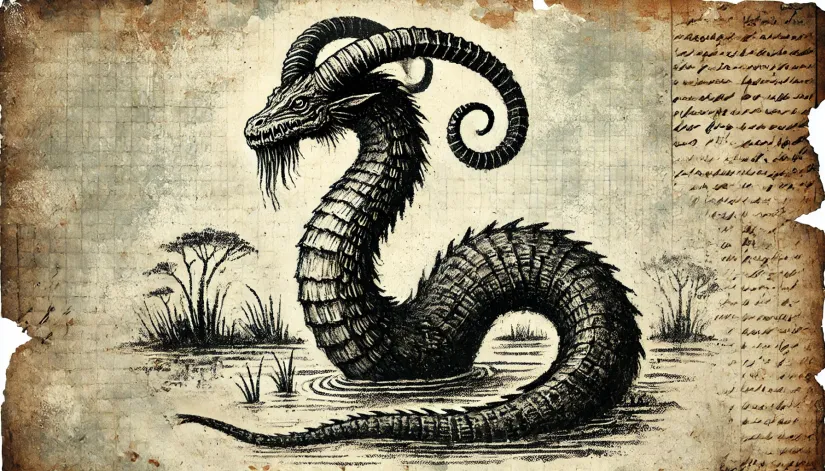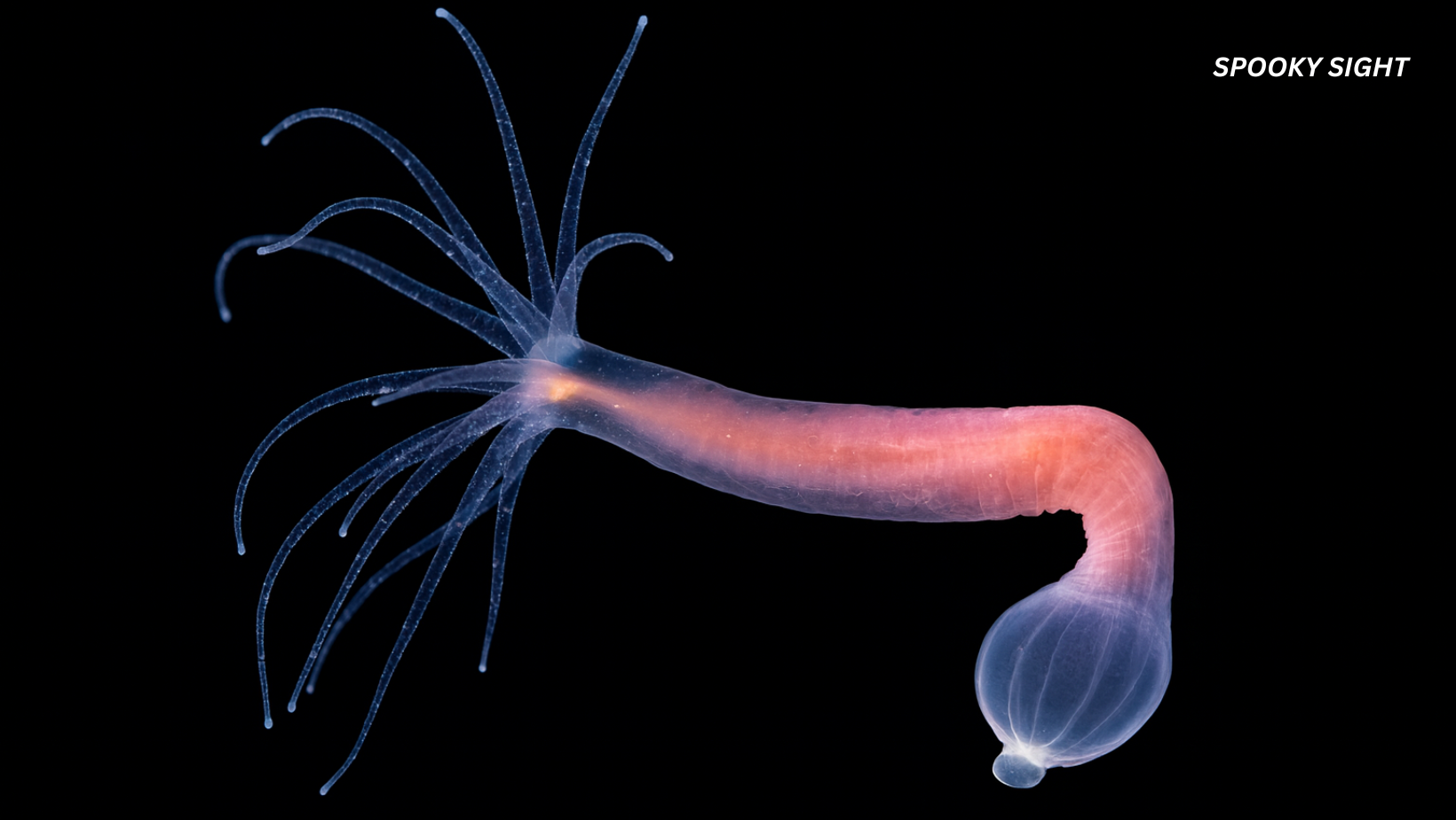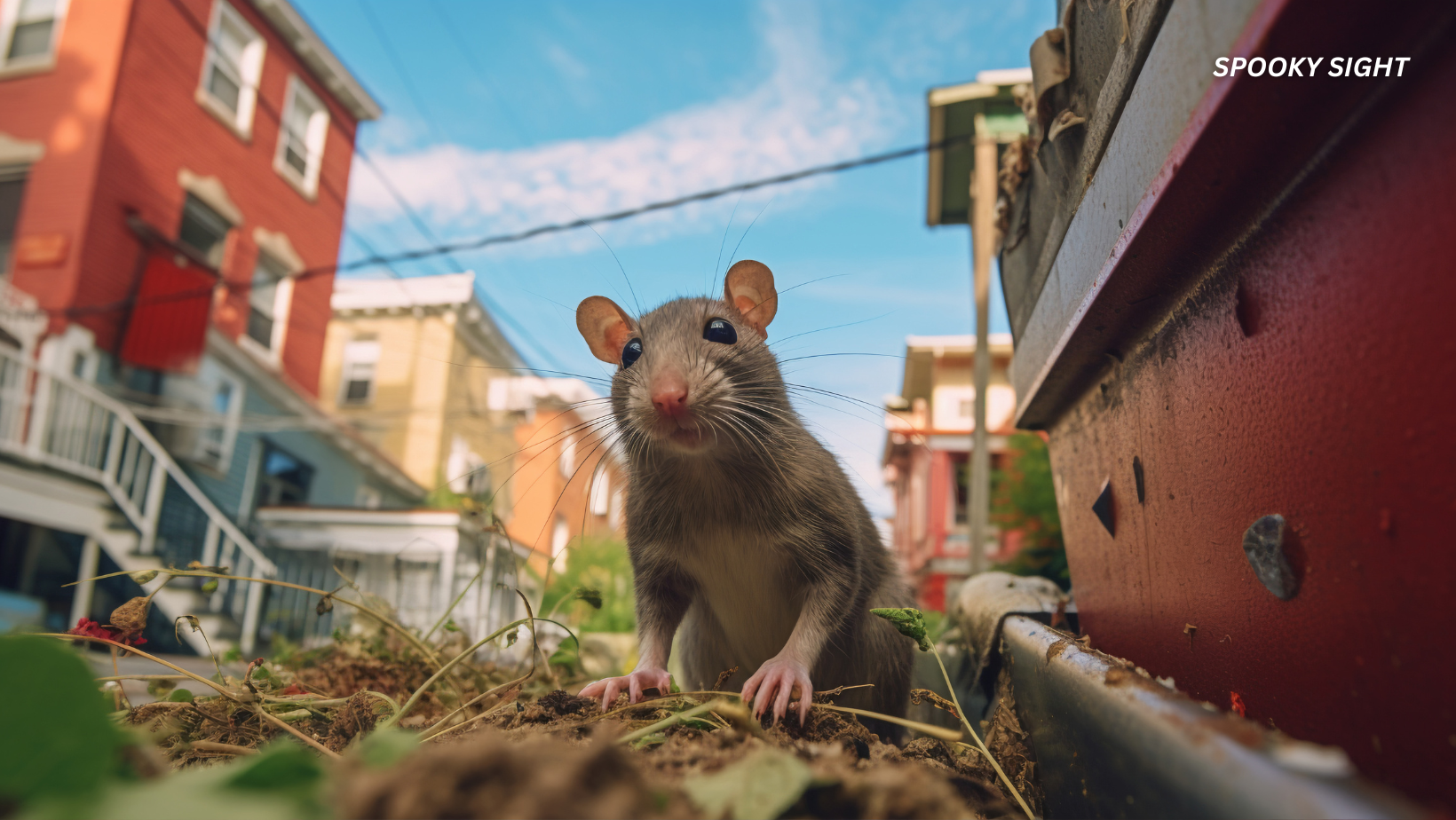The Ninki Nanka is a strange African cryptid that, according to rumors, can curse anyone who sees it. Those who encounter the monster with the head of a crocodile and the donkey’s body (or a blend between a hippopotamus and a giraffe) will fall ill or die soon after.
Yet, despite the danger, many claim it still roams West Africa’s swamps, although sightings have become increasingly rare.
In this article:
What Is the Ninki Nanka?
The Ninki Nanka (also known as Ninkenanka or Landouman) is a legendary beast in West African folklore. According to these stories, it’s a dragon-like creature that lives in the swamps, rivers, and mangroves of Gambia, Senegal, and Guinea.
Locals have passed down these stories for generations. They typically associate this massive African cryptid with various water spirits, natural disasters, and even mysterious illnesses.
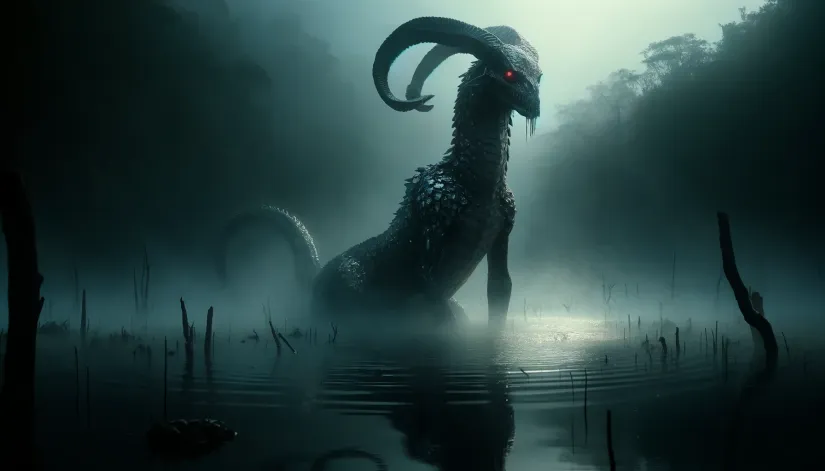
Physical Description: Serpent, Dragon, or Something Else?
So here’s the first important question: What does the Ninki Nanka look like?
Well, that’s where things get interesting—and complicated.
Depending on who you ask, you’ll get different answers. Some say it’s a giant serpent. Others may describe it as a full-blown dragon with wings, legs, and a face that would send shivers down anyone’s spine.
Here’s what we know: most accounts agree it’s massive. Some claim this creature can grow up to 160 feet long—longer than the largest whales. It’s so big that when it swims in the rivers and swamps, it can generate waves strong enough to knock over boats.
In certain legends, the cryptid has mirror-like scales (which can reflect sunlight so brightly that it’s blinding) tough enough to repel arrows, spears, and even bullets.
SpookySight recommends:
- What is the Marozi, Kenya’s Legendary Spotted Lion?
- Beware of Madremonte: This Colombian Cryptid Punishes Those Who Harm Nature
- Is the Flatwoods Monster Real? An In-Depth Investigation of the 1952 Sighting
The Ninki Nanka’s face is another bizarre element. In some reports, “eyewitnesses” speak of a horse-like face, elongated with an eerie grin. For others, it looks more like a kangaroo. Either way, its eyes almost always glow (in red or gold).
Other unusual physical details include massive horns on its head (curling like a ram’s or standing tall like those of a gazelle), a feathered crest running down its back (shimmering in iridescent colors), and a long, giraffe-like neck that lets it tower over trees.
Believe it or not, everything we have described is part of this African cryptid’s more “believable” characteristics.
Next, it’s the crazy stuff.
A 1906 commissioner’s report describes the creature:
“The Mandingoes are firm believers in genii; every village is supposed to have two of these, a bad spirit and a good spirit. In some cases they say the village spirits or genii are male and female, sometimes the male is good and the female bad, and vice versa. A well-known Mandinka myth is the “ninki nanko”; this is supposed to resemble a gigantic crowned serpent which resides in the thickest bush. If a native sees the body of this creature he believes that he will be afflicted with dangerous sickness but that if he sees the eyes or crown it means instantaneous death. No native will go anywhere near where one of these creatures is supposed to be.”
So, the cryptid may have magical powers. It can shapeshift and transform into other animals—or even humans—to lure in its victims. It can also turn invisible, making it even more dangerous because you won’t know it’s there until it’s too late.
And then there’s its breath. According to some legends, Ninki Nanka can emit toxic vapos. In certain versions of the tale, it can even breathe fire. Pretty much like the mighty dragons of European lore.
With all these conflicting descriptions, it’s easy to see why the creature remains such a mystery.
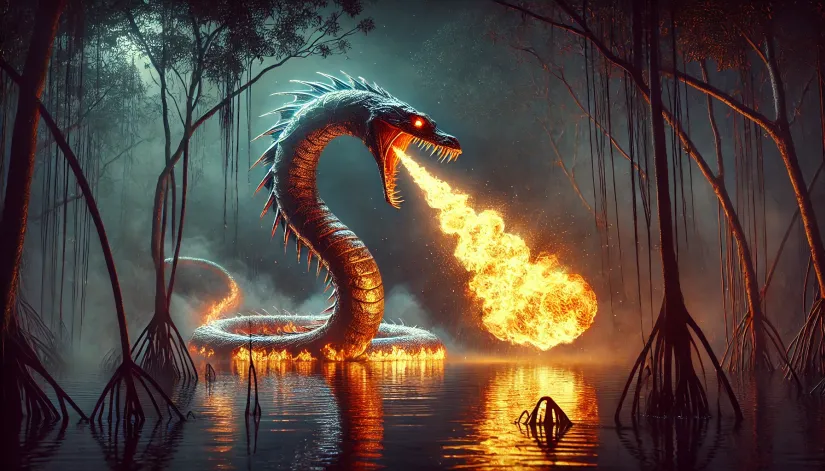
Ninki Nanka’s Origins
Stories about the Ninki Nanka circulate in Gambia, Senegal, Guinea, Sierra Leone, and Mali.
This mysterious African cryptid is often associated with water bodies—rivers, lakes, and swamps—where many believe it lives.
The creature is also viewed as a protector of nature, defending against those who disrespect the environment. If you mess with the swamps or rivers, you might just provoke the beast. In other variants, it’s a bringer of death and misfortune, especially to those who set eyes on it.
In rural areas, parents often use the legend to keep kids away from dangerous waters. “Don’t wander near the river, or the Ninki Nanka will get you!” they warn. It’s an effective way of keeping the young away from potentially dangerous waters.
However, while the monster can be very real for those living in more isolated communities in urban areas (like Banjul in Gambia), most dismiss the legends as superstition.
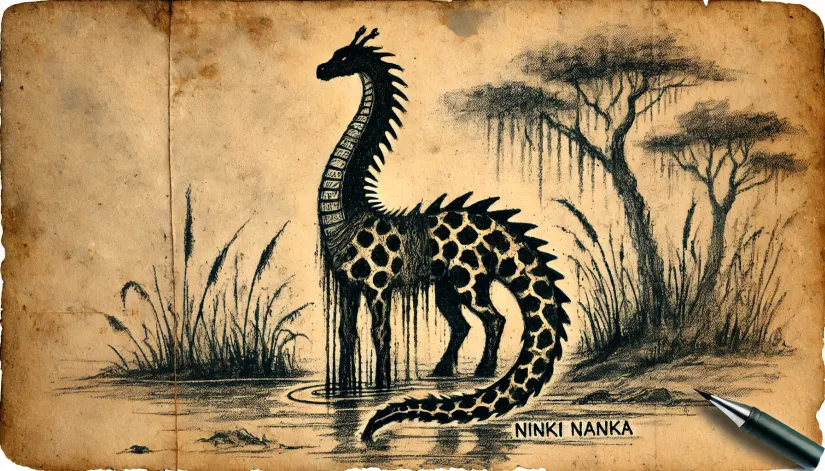
Historical Sightings and Eyewitness Accounts
Throughout the years, multiple Ninki Nanka sightings have been reported.
Apparently, a Ninki Nanka was allegedly killed with a machete by “an old wise man.” He then buried its body on South Beach.
Then, there’s another story about a jeweler’s uncle who saw the cryptid swimming upriver from Kotu “many years” before 2006. The man died within five years, and the jeweler was convinced it was because of the sighting.
Related: Is the Grootslang Real? Discover The Legendary Beast of Africa
Oh, and there’s another tale of someone finding a strange creature with a kangaroo face and forked tongue coiled in the bushes. That person died after the sighting, too.
Here are some other noteworthy sightings:
The Lake Near Banjul (1911)
In 1911, locals near Banjul believed a dragon—likely the Ninki Nanka—lived in a nearby lake. When British authorities planned to drain the lake, the villagers grew anxious.
According to legend, they used a mirror to confront the beast, believing it would be scared off by its own reflection. Strangely, the tactic seemed to work, and the creature was never seen again.
Dr. Thomas Dalrymple’s Report (1935)
In 1935, a man named Dr. Thomas Hardie Dalrymple reported local accounts of a Ninki Nanka sighting by the River Gambia.
According to Dalrymple’s notes, excited villagers told him the creature had emerged from the mud on a moonlit night. The monster had a horse-like face, a giraffe-like neck, and a body like a crocodile, stretching up to 30 feet long.
Papa Jinda’s Sightings in Abuko (1943 and 1947)
A few years later, in 1943, there was another alleged sighting. A man named Papa Jinda in Abuko claimed to have seen the Ninki Nanka while working in the fields.
Though he wasn’t harmed, the sighting left him rattled.
Four years later, he reencountered the creature. This time, Papa Jinda fell ill shortly afterward and died, leading locals to believe the creature had cursed him for seeing it twice.
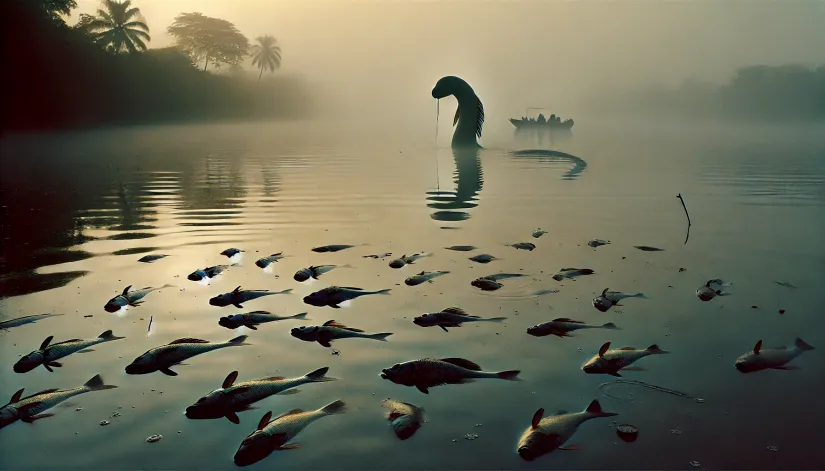
The Gambia River Incident (1993)
In 1993, thousands of fish mysteriously died in the Gambia River, floating lifelessly on the water’s surface. While environmentalists searched for logical explanations, some locals suspected the poisonous remains of the Ninki Nanka were to blame.
The Park Ranger Encounter (2003)
In 2003, a park ranger in Kiang West National Park claimed to have a face-to-face encounter with the cryptid. Afterward, the ranger fell ill with strange symptoms, including fever and skin lesions.
Fearing a curse, he sought help from a local Imam, who performed rituals that reportedly healed him.
Cryptid or Myth?
In 2006, Richard Freeman (a leading British cryptozoologist), with the help of the Centre for Fortean Zoology (CFZ)—a British society known for investigating cryptids—organized an expedition to Gambia. Their goal? To gather undeniable firsthand proof that this monster is real.
Over a few months, the team interviewed locals, ventured through swamps, and collected samples.
Based on the collected evidence, Freeman proposed that the Ninki Nanka might be a large, swamp-dwelling monitor lizard—possibly an undiscovered species or even a surviving member of an ancient lineage of reptiles. His theory was grounded in Freeman’s extensive experience working with reptiles and other cryptids.
Related:
- Tatzelwurm: The Alpine Cryptid You’ve Never Heard Of
- Mongolian Death Worm: Fact or Fiction? Inside the Gobi Desert’s Greatest Mystery
- 16 Fascinating Facts About the Loch Ness Monster
Freeman also suggested that reports of a fire-breathing, mirror-like scales monster could be embellishments over time. Possibly based on the sheen of wet scales in the sun or fear-influenced exaggerations.
Another expert, Dale A. Drinnon, theorized that the creature might be a misidentification of large aquatic animals such as elephant seals or giant stingrays.
According to Drinnon, sightings of these animals in unfamiliar environments (like inland rivers) could easily be interpreted as something more fantastical, especially by those unfamiliar with them.
We can also draw parallels between this African cryptid and ancient python deities in West African religion. Perhaps the creature could symbolize a demonized water spirit or a pre-Islamic deity? And, over time, the new religious beliefs that quickly spread in the region may have transformed these spiritual figures into feared creatures of folklore.
Another theory we have is that Ninki Nanka could easily be linked to extinct species (like Sivatherium, a giraffe-like mammal that roamed parts of Africa in prehistoric times). That could explain its large size and distinct features—such as horns.
Ninki Nanka in Popular Culture
In 1984, the Senegalese band Touré Kunda released the album Casamance au Clair de Lune, which includes a track titled “Ninki Nanka.” This song blends traditional African sounds with contemporary music, keeping the legend alive for new generations.
The cryptid also appeared on the TV show “Destination Truth,” where host Josh Gates traveled to Gambia to investigate the creature. While the episode didn’t provide definitive proof, it helped introduce the legend to a global audience.
Frequently Asked Questions
How long is the Ninki Nanka?
According to various eyewitness reports and local legends, the Ninki Nanka can grow to an astonishing 160 feet long. That’s longer than many of the world’s largest known animals, contributing to its larger-than-life status in folklore.
What does the Ninki Nanka look like?
Descriptions of the Ninki Nanka vary widely. It’s often said to have mirror-like scales, a feathered crest, a giraffe-like neck, and a horse-like face. Some accounts describe it with legs and wings, giving it a more dragon-like appearance. In contrast, others say it resembles a giant serpent.
Is the Ninki Nanka real?
Ninki Nanka’s existence hasn’t been scientifically proven. While it holds a significant place in West African folklore, and there are many reported sightings, no physical evidence has been found to confirm its existence.

